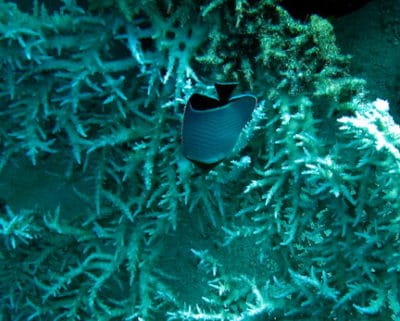On most of the reefs I have dived on over the last ten days, I can always find a coral that is missing some of its tissue. Most often, it’s been eaten by some other animal.
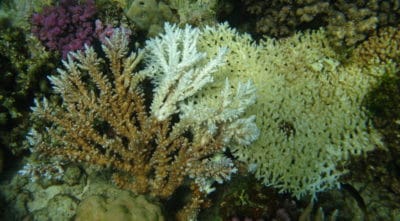
Two colonies of Acropora, one completely eaten and a second partially eaten by a crown of thorns sea star.
Probably one of the most common examples of this in the Red Sea is antler or cauliflower coral, genus Pocillopora. This coral seems to be a tasty snack for the snail known as Drupella. These are usually in groups that start to feed at one end of the colony and, over a period of days to weeks, will eat the entire colony before moving on to another. This usually isn’t much of a problem since this coral is really common; it grows fast and exhibits really high rates of recruitment. These snails can become a real pest though, especially during an outbreak. While some fish and a few invertebrates may eat them, they find protection among the branches of corals, where they remain tucked away in the day.
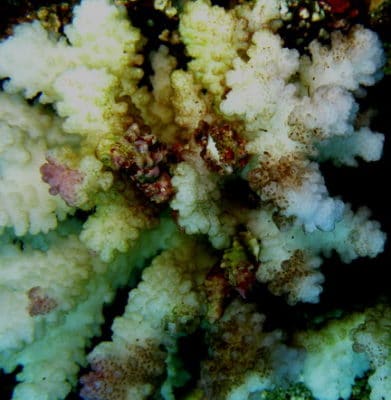
Drupella snails on a colony of antler coral (Pocillopora).
Another snail, Coralliophila, seems to prefer massive Porites colonies. They occur in large aggregates between lobes of the coral. These snails are unusual corallivores, because they don’t have a radula (rows of teeth) like Drupella. they use a proboscis to slurp up coral tissue. Unlike the Caribbean species of Coralliophila, they usually don’t seem to eat much tissue either.
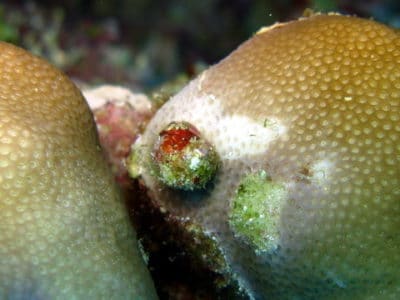
The snail Coralliophila and a recent lesion caused by this snail on Porites.
More than 160 animals are known to eat coral. These animals are known as corallivores, and include species known to feed only on coral (obligate corallivores) many more that coral is just one part of their diet (facultative corallivores). Most are fish (11 families), but there are also 51 species of invertebrates –several snails, worms, sea urchins, crabs and sea stars. There are many more corallivores in the Indo-Pacific and red Sea than in the Atlantic, but there are also many more species overall, including lots more types of coral for them to feed on.
Corallivores feed in many ways – some remove only the soft parts (the polyps) without damaging the skeleton, and some consume only coral mucus. Others, known as scrapers, remove a bit of the underlying skeleton when eating coral tissues, while excavators remove coral tissue and a substantial amount of the skeleton.
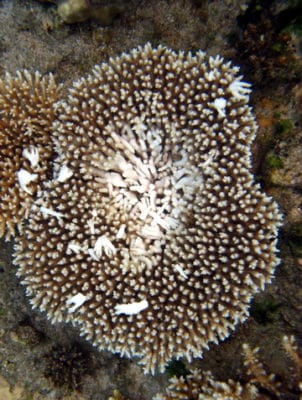
An example of a predation scar caused by a bumphead parrotfish.
One type of corallivore that has been well studied, and is often used as an indicator in monitoring programs is the butterflyfish. These fish have a delicate mouth shaped like a snout, that can remove a single polyp without causing much damage to the skeleton. They can be routinely observed pecking away at corals, without ever causing much damage.
Other ones, like several of the large parrotfish, routinely ingest coral as well as the reef substrate as they feed on algae, and you often hear them crunching away at the reef and on corals. One of these, the bumphead parrotfish is reported to use its forehead to break corals. This is the largest parrotfish, reaching a weight of 70 kg or more.

About 50% of the diet of a bumphead parrotfish consists of coral.
Probably of most concern is the starfish (sea star) commonly called the crown of thorns or COTS (Acanthaster plancii). A single specimen of this voracious predator can eat up to 6 square kilometers of coral in a year and aggregates of these sea stars often cause nearly 100% mortality to localized areas.
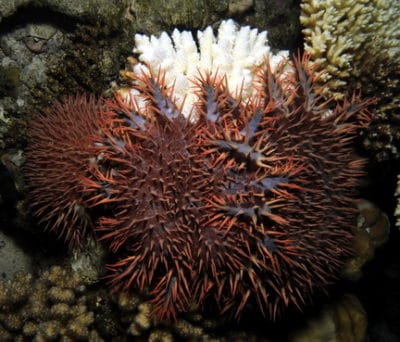
Three COTS at night, eating a table Acropora.
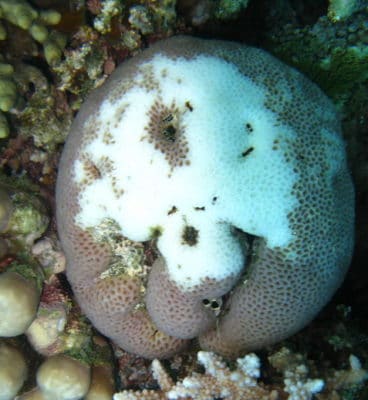
An example of COTS predation on a massive coral (Goniastrea).
It likes the fast growing corals like Acropora most, followed by Pocillopora and Montipora, but it will eat many other corals too, especially after it has eaten all the branching corals. On many Pacific reefs, COTS periodically reaches high population densities capable of destroying large reef tracts. During outbreaks they reach densities of 4-6 individuals per square meter.
I’ve found a few of these sea stars in the Farasan Banks. So far they are pretty rare, except for one site. At my favorite shallow site we have seen to date, I saw signs of predation everywhere, from over 70 feet into the shallows (1-2 m). This reef had the largest and densest thickets of staghorn coral, hundreds of table corals, and many other species of Acropora, along with a host of other corals.
Yet, there were lots of dead table corals and many that were missing half their tissue or more. White skeletons that had been eaten over the last few days stood out in stark contrast to the vivid colors of live coral. Evidence of COTS predation, but where were the sea stars?
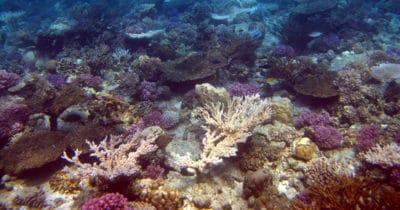
The reef flat with many dead table corals eaten by COTS over the last several weeks.
There was not a single COTS on any of these corals. After a bit of searching around the base of the colony, I had my answer. The sea stars were tucked into crevices at the base of the corals, out of site of their predators. These are mostly nocturnal predators emerging after dark to feed.
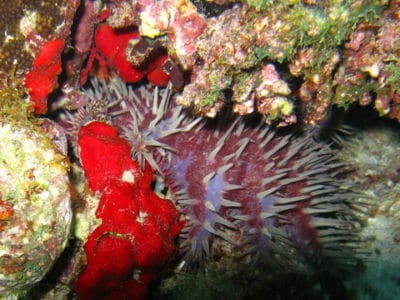
A crown of thorns seastar hidden away in a crevice during the day.
I wanted to know how common they were. So a small group of us returned to the reef at dusk first for a snorkel, and then a night dive. Around dusk, the COTS were still hidden. Around 7 PM we entered the water, equipped with cameras, flashlights and our slates with underwater paper, each buddy team heading off in a different direction. Searching under and around each table coral, we found the culprit – some were on the bases of colonies, not yet feeding.
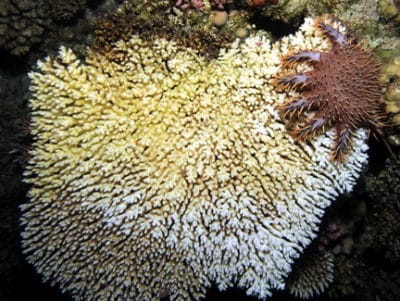
COTS emerging from its refuge at night to finish eating a table coral.
Towards the end of our dive, they emerged from their protected refuge and climbed atop the corals to begin feeding. Most corals each were being eaten by a single COTS. Several, though, had two, three and even four COTS piled on top of each other.
What is the prognosis for this reef? This morning we conducted many transects in shallow water to better characterize the amount of damage. While there were a lot of dead corals, and a lot that had been partially consumed, some taxa appeared to be avoided. I also noted a lot of small colonies of their preferred food that were completely live. Its too soon to know the fate of this reef, but there appears to be a lot more coral, including many juvenile colonies, than the COTS can eat, so there is hope.
In many places efforts have been undertaken to remove these voracious predators, especially during outbreaks. In some of the earliest attempts, people cut them up, which is not a great idea since they can regenerate their limbs. They’ve also been collected and removed from the reef. This is a difficult task, given their venomous spines and their ability to hide during daylight. Others are working to develop bait stations, using COTS pheromones to attract them. More recently, a group identified the presence of a Vibrio (a pathogenic bacteria) in their gut. They’ve cultured these in great numbers and then inject the COTS with a lethal dose, which ultimately kills them.
Controlling populations may be one localized solution, but probably not the answer. We need to understand more about what causes outbreaks, and we need to restore their predators – like the trumpet triton (Charonia), a large snail that has been collected in unsustainable numbers for shell collectors.
Just another reason why you shouldn’t purchase shells and corals. These animals belong on the reef, not on a shelf collecting dust.
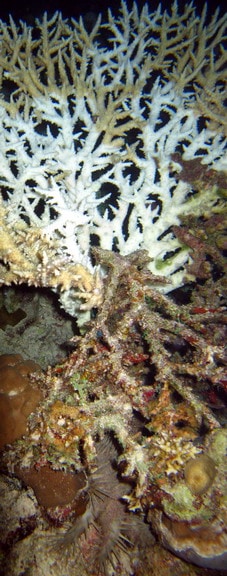
A branching colony of Acropora preyed upon by a crown of thorns sea star. The COTS is visible at the base of the coral.
